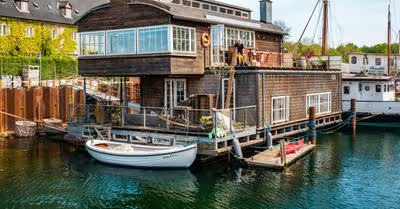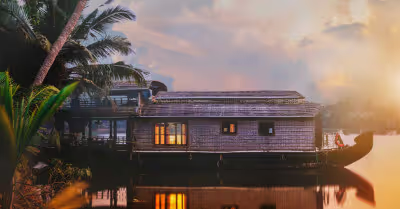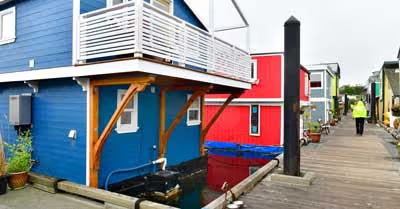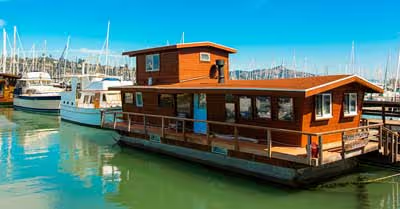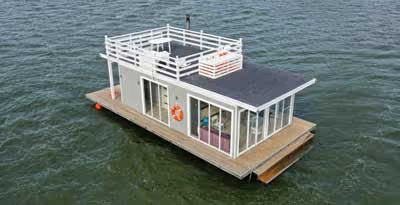
Houseboat hulls come in many varieties. But which is best overall, and what hull type is best for lakes, rivers, and rough water?
The best houseboat hull design overall is the fiberglass v-bottom due to its ability to ride through rough water. The second best is the flat bottom, as it has very little draft and it's easy to maintain. Multihull and pontoon houseboats are good for some applications, such as lakes and rivers.
In this article, we'll cover the most common houseboat hull designs and their best uses. We'll cover the advantages and disadvantages of each common design, and we'll also overview the most common materials houseboat hulls are made from. Finally, we'll go over the best uses for each type of houseboat hull.
We sourced the information used in this article from reputable boat design guides and from houseboat manufacturers.
Why Does Hull Design Matter?
The hull design is perhaps the most important design and engineering element of a houseboat. The hull is what allows the vessel to float, and it also has the biggest influence on its handling characteristics, durability, and stability. A well-designed houseboat hull can safely transport the weight of a houseboat and its occupants and stand up to wind and some level of choppiness.
A poorly designed houseboat hull puts the boat at risk of capsizing or sinking and also reduces the efficiency of the propulsion system. Additionally, badly-designed hulls require more repairs and maintenance than proper designs, increasing costs and headaches for owners and businesses.
Houseboat Hull Materials
Houseboats are built with many different hull materials, but some are more common than others. We researched the most common houseboat hull construction materials and listed them below in order of most common to least common.
Fiberglass Houseboat Hulls
Fiberglass is the most common houseboat hull material today. Fiberglass hulls are cold molded using a mixture of glass fiber and resin, which hardens to form a durable and watertight material. The beauty of fiberglass is that it can be formed to any shape while wet in paste form, and it dries at room temperature to a rock-solid material.
Fiberglass is very durable and long-lasting. It doesn't really rot, it can take impacts, and it's easy for amateurs to maintain and repair. This is why it's such a common boat building material and a great choice for houseboats. Generally speaking, fiberglass hulls are not found on multihull houseboats and are typically used on flat-bottom and V-bottom designs.
Aluminum Houseboat Hulls
Aluminum is a common houseboat building material, though its use seemed to peak in the 1970s. Aluminum houseboat hulls have a few notable advantages, including their resistance to corrosion and strength to weight ratios. Aluminum hulls don't need to be coated or painted, as aluminum doesn't rust.
Aluminum houseboats tend to be in the premium price range, as they're preferred by owners but much more expensive to produce. Aluminum can also be tricky to repair, as you can't weld it using normal arc or MIG welding. Additionally, aluminum itself is more expensive than steel. But many of the best houseboats ever made use of aluminum in their hulls and superstructures.
Steel and Stainless Steel Houseboat Hulls
Steel and stainless steel, though different materials, are just about equally common for houseboat hulls. These materials are the most durable out of the bunch, and they're generally used for heavy-duty applications. One of the benefits of building with steel is that it's cheap, and almost any boatyard can construct or repair a steel hull.
One of the downsides of steel is that it corrodes. Regular steel rusts and must be frequently painted, and stainless steel corrodes rapidly when in contact with saltwater and certain dissimilar metals. But stainless steel is a great material for pontoons, which many houseboats float on. It's also necessary for houseboats that are too large for fiberglass construction.
Wood Houseboat Hulls
Wood is the most popular houseboat material for home builders, as it's easy to work with and inexpensive. Most wooden houseboats built in the last 50 years have a layer of fiberglass to seal the wood hull from the elements. Wood, specifically plywood, houseboat hulls are durable and long-lasting, provided they're well-maintained.
There's nothing wrong with a wooden houseboat. However, rot is a serious threat for wooden houseboat hulls, especially if their owners neglect maintenance. It doesn't take long for water to ruin a wooden hull, especially if it's made with substandard construction plywood. Houseboats built with hardwood, like sailboats, exist, but they're extremely rare.
Houseboat Hull Shapes
Next, we'll cover the shapes and types of hulls used on houseboats. Next to hull material, houseboat hull shape is the most important design factor to consider when choosing a houseboat to purchase. Houseboat hull shape has a direct effect on the handling and comfort of a houseboat, not to mention its safety.
Flat-Bottom Houseboat Hull
Flat-bottom houseboats are the most common on the water today. The design of a flat-bottom houseboat is extremely simple. It's just a flat tub in the water, which is great for calm and shallow waters. Flat bottom houseboats are easy to beach and also simple and inexpensive to produce.
You can have a flat-bottom houseboat made of almost any material, including wood, steel, and fiberglass. These vessels are easy to store and maintain, as they can be set flat on the ground and don't require a deep trailer. Additionally, it's easy to navigate shallow water because flat-bottom houseboats have the least draft.
V-Bottom Houseboat Hull
The v-bottom houseboat hull is a relatively new design, and it's more robust than traditional flat-bottom hulls. A v-bottom houseboat hull has a slight V shape, which means it's at an angle to the water and never lies directly flat on it. This has advantages in choppy water, as it reduces pounding. These vessels also track straight in the water, resist wind movement, and steer better.
V-bottom houseboats come in many shapes and sizes, and some have a more pronounced shape than others. This is great for areas where houseboats need to cut through chop, but not so good for super shallow waters. It's more difficult to beach a v-bottom houseboat, as it may not lay flat in the bow. Additionally, it won't be as secure, or it may cut too deep into the sand.
Pontoon Houseboat Hull
Pontoon houseboats are extremely common and also robust. These vessels, which work the same way as regular pontoon boats, use two or three sealed metal tubes to float. Aluminum is the most common material for pontoons, though houseboats occasionally have steel pontoons for added strength or ballast.
Pontoon houseboats are easy to build and pretty affordable. They're also easy to navigate, as the sharpened bow of each pontoon helps the vessel track straight in the water. The primary downside of pontoon houseboats is that they're easy to overload. Also, aluminum pontoons are easy to damage and costly to repair.
Multihull Houseboats
Some houseboats with fiberglass or steel hulls are available as catamarans or trimarans. This is distinct from pontoon houseboats, as multihull houseboats have integrated hulls instead of separately-made pontoons. Multihull houseboats are extremely efficient and handle rough water well, though they're generally more expensive to produce and thus costly to own.
Best Houseboat Hull Design for Rough Weather
Occasionally, houseboats cruising on inland waters are bound to encounter windy days or choppy water. The worst possible hull to have in this situation is the flat-bottom, as it will pound and shake the crew and cabin to pieces in high waves. The v-bottom and the multihull are the best choices, as they can cut through waves rather than pounding on top of them.
Most Affordable Houseboat Hull Design
The flat-bottom is generally considered to be the most affordable houseboat hull type. These hulls are easy and cheap to produce, and they're also inexpensive to repair and maintain. Most flat-bottom houseboats are made with fiberglass, which any owner can repair with a simple kit from West Marine.
Best Houseboat Hull Design for Stability
Flat-bottom hulls are known for their stability, as they have an enormous amount of contact with the surface of the water. This allows the owners to put more weight in the boat, as it resists displacing water more than pontoon or v-bottom houseboat hulls. This, combined with their affordability, is why flat-bottom houseboats are so common.
Best Houseboat Hull Design for Lakes
The best houseboat hull type for lakes is the pontoon houseboat, as it's easy to use and retains a shallow draft. Pontoon houseboats are resistant to wind, as their narrow hulls act as stabilizers and keep the boat tracking in a straight line when under power. V-bottom houseboats are also great, but flat-bottom houseboats may pound on chop or boat wakes.
Best Houseboat Hull Design for Rivers
The flat-bottom and the multihull houseboat are ideal for rivers. Flat-bottom houseboats are great because of their shallow draft, and multihull houseboats are ideal due to their stability and ability to resist currents. Twin hulls can keep your boat stable and increase efficiency while traveling upstream, as the gap in the center allows flowing water to pass under the boat without pushing against it.
Best Overall Houseboat Hull Design
The v-bottom is the most robust design for houseboat hulls. This rule also applies to powerboats, as the v-bottom is simply a great choice for most conditions. It works in almost all environments, and it's exceptionally good in rougher waters. If you had to pick just one hull design for your houseboat, you'd get the most value from a v-bottom.



